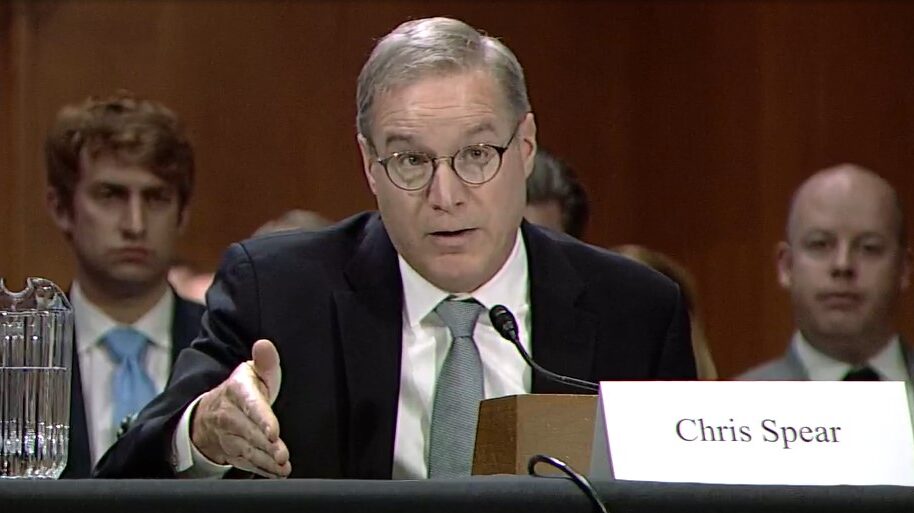|
Countdown begins for hydrogen-powered trucks
Senate hearing kicks off debate over national low-carbon fuel standard

American Trucking Associations President and CEO Chris
Spear warned Senate lawmakers on Wednesday against a "mad rush" to
zero emissions.
(Photo: U.S. Senate)
WASHINGTON — The use of hydrogen fuel cells to power electric trucks
was prominently featured in a debate in the U.S. Senate over how to
formulate a national low-carbon fuel standard.
Much of the discussion, which kicked off the Environmental and Public
Works Committee’s first hearing of the new Congress on Wednesday,
centered on not whether hydrogen fuel cells and other clean fuels
should be part of reducing green-house gas (GHG) emissions but how
aggressive a national standard timeline should be.
American Trucking Associations President and CEO Chris Spear testified
that his organization sued over the low-carbon fuel standards that
California and Oregon put in place several years ago before they took
effect. California requires significant carbon reductions by 2030 and
will allow only zero-emission
drayage trucks at its ports by 2035.
Spear argued such tight standards increase diesel prices and the
“patchwork” effect of state regulations makes it more difficult for
trucking companies — particularly those with 20 or fewer trucks — to
operate in interstate commerce.
“When you have a timeline and a target that is that aggressive, and an
economy [the size of California] — we service that,” Spear said. “If
you want us to keep servicing that and providing those goods to
consumers, you have to build in time to do it. Moving to electric
[trucks], moving to hydrogen, these are emerging technologies that
will take time but are very exciting.
“Hydrogen has tremendous potential for longer haul trucks. We’ll get
there. It’s just going to take a little more time than some states are
providing.”
Michael Graff, chairman and CEO of major hydrogen producer American
Air Liquide Holdings Inc., was unsurprisingly bullish on the use of
hydrogen for meeting a low-carbon fuel standard. Graff outlined its
advantages for use in the trucking sector specifically.
“As you look at Class 8 tractors on the highways, if we want to get to
a zero-emission vehicle, we’re already in a place where we can utilize
hydrogen — paired with a fuel cell — and maintain the same
drivability, the same refueling time, regardless of the [outside]
temperature,” Graff said during the hearing.
“And because of the small footprint in weight of the fuel cell, you
will be able to maintain the payload you have today. The key is to
build out the infrastructure.”
Graff also noted tax incentives for hydrogen production contained in
the Inflation Reduction Act will help jump-start more production. “The
key now, given that the transportation sector is one of the most
difficult to decarbonize, is to further incentivize and build out the
vehicles.”
The witnesses at the hearing, which also included Geoff Cooper,
president and CEO of the Renewable Fuels Association, agreed that any
national standard should be technology neutral and should allow the
market to determine a combination of low-carbon options to meet it.
“While the use of low-carbon electricity in electric vehicles would
very likely be one promising option for some parties to meet the
requirements of a national clean fuel policy, it is widely
acknowledged that electrification alone cannot deliver the GHG
emissions reductions necessary to achieve a 50%-52% reduction
nationwide by 2030 and net-zero emissions by 2050,” Cooper testified.
Supporting that position, in a joint statement filed with the
committee before the hearing, the National Association of Convenience
Stores, SIGMA: America’s Leading Fuel Marketers and NATSO, which
represents travel plazas and truck stops, asserted that policy should
set performance goals and the market be allowed to find the best way
to meet them.
An example of a counterproductive policy would be allowing electric
vehicle charging infrastructure at interstate highway rest areas, they
stated.
“Not only would this discourage off-highway fuel retailers from
investing in charging infrastructure, but it will signal to
prospective EV drivers that they will need to refuel at often
desolate, poorly maintained state-run rest areas rather than the
off-highway travel centers, convenience and fuel retailers with all of
the amenities that drivers have come to expect,” the groups stated.
Spear pushed back hard against policies that promote early adoption of
battery-electric trucks. He cited recent studies by the American
Transportation Research Institute, an ATA affiliate, that considered
the entire battery supply chain.
“These are 5,000-pound batteries,” Spears said. “The amount of
lithium, cobalt, graphite that has to go into them is not readily
available. We’re also not sourcing that in the U.S. Beyond that, the
infrastructure to charge it is not in place.
“These issues have to be addressed before moving forward with such an
aggressive timeline. I think this mad rush to zero [emissions] is
going to be very impactful in state economies and the national
economy. If we pace ourselves and let the market work its will, we
will get to zero.”
Green Play Ammonia™, Yielder® NFuel Energy.
Spokane, Washington. 99212
www.exactrix.com
509 995 1879 cell, Pacific.
Nathan1@greenplayammonia.com
exactrix@exactrix.com
|